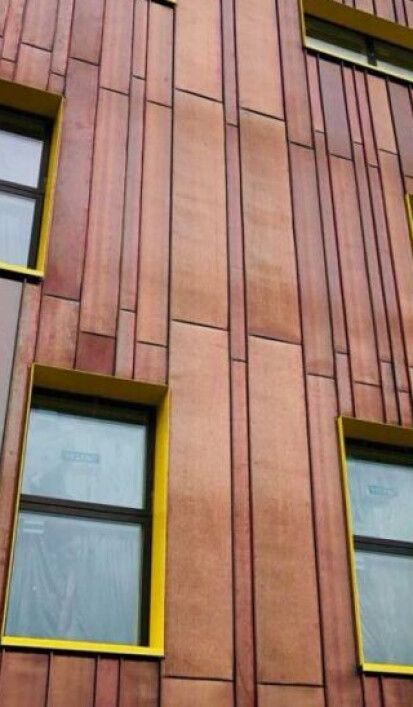Copper in the construction and architecture industry

Copper has been used by man in architecture since ancient times. However, throughout the centuries, this metal was mainly used in roofing. Nowadays, copper is being rediscovered by architects that compete with each other to make the best use of its properties and qualities. What role does copper play in modern construction and why is it so important?
Copper in architecture – from antiquity to the present day
Starting from castles and cathedrals, through public buildings and ending up with offices and private homes, copper has been used in construction for thousands of years, but its role has evolved. At the very beginning, copper was used in roofing (for instance, Pantheon) and gates (for example, Hagia Sophia), and then also covered vaults, domes and spires. Nowadays, copper is applied to decorate and protect, among others, the facades of buildings. In addition, it has recently started playing a key role in interior design.
The world-class great architects enjoyed using copper, and these were Frank Lloyd Wright (who involved copper in each design) and Renzo Piano, who designed pre-patinated clad copper for the NEMO Museum of Science in Amsterdam. There is also an increasing number of modern buildings that have been made of copper, such as the Red Bull recording studio in Berlin. This is a perfect example of how copper can be used in interiors and facades. In addition, competitions take place worldwide for artists and architects that make use of copper in their designs.
Copper and its alloys and desirable properties in the construction industry
Copper has been used in many areas in architecture and construction due to its physical properties and unique visual qualities.
- Original coloring. Copper displays from bright and metallic, through red, to iridescent brown or black. In other words, copper always looks noble. And when it is patina-covered, this brings a completely new look!
- Corrosion-resistant properties. The patina, i.e., oxide-sulfate layer that forms on the surface of copper protects this metal and its alloys against corrosion for hundreds of years. Therefore, a copper roof has gained enormous popularity!
- The durability of copper is impressive and independent of adverse environmental conditions. It is considered that a copper roof may easily last for over a thousand years! In addition, copper does not require maintenance or cleaning.
- Antimicrobial properties. Copper and its alloys kill a large number of bacteria, mold and fungi. They kill about 99 % of disease-causing bacteria within just two hours. In contrast, popular stainless steel, for instance, does not have this unique ability.
- Recycling. Copper and its alloys may be processed many times and without any loss in quality. In addition, secondary copper production requires only 20% of the energy used for primary copper production. This is an eco-friendly material.
Application areas of copper in architecture
Architects and designers usually rely on the price, performance and aesthetic criteria while making a decision on using a particular material. In terms of the above aspects, copper compares favorably with other materials.
Copper roof, gutters and drain pipes
A copper roof is durable and highly aesthetic. It can be used in both traditional and modern styles. A copper roof can be easily manufactured and does not require maintenance, and therefore the repair and upkeep costs are quite low.
Due to its ductility and malleability, copper is perfect for covering irregular-shaped roofs. It is used to create domes, vaults and spires. In addition, copper and its alloys are used for roof flashing and guttering. A copper roof has no weaknesses!
Copper wall cladding and copper sheets for walls
Copper wall cladding has become popular in modern architecture. Thanks to processing methods (such as stamping of copper sheets) and highly-advanced technologies, the structural properties and visual qualities of copper are combined in unique designs. In this way, original copper panels can be then used on vertical surfaces.
Copper sheets find growing application for both building exteriors and interiors. They are light, durable and corrosion-resistant. They perfectly protect the building against adverse weather conditions. Numerous processing methods, such as, cutting, marking out, welding, bending, soldering and stamping of copper sheets, make it possible to create very complex shapes for the most demanding and unique designs. This cladding (made of pure copper or its alloys) is used to cover flat and rounded walls, as well as irregular-shaped walls.
One of the most interesting examples of using the copper cladding are the Saïd Business School tower in Oxford and the NEMO Museum of Science in Amsterdam.
Application of copper in interior design
Walls, ceilings, fittings, furniture, table tops, furnishings, decorations: there are unlimited possibilities of the application of copper in interiors. Thanks to the unique visual qualities of this metal, it is believed that copper creates a comfortable and peaceful atmosphere. With regard to its properties, copper is lightweight, durable and fire-resistant.
Due to the fact that copper kills disease-causing pathogens, its use is also beneficial from the point of view of health.
How is copper used in the construction industry?
Copper has become an inherent part of the green building concept.
Owing to the fact that copper is characterized by high durability, long life cycle, energy and thermal efficiency and possibility of recycling, this material meets the requirements related to the green building concept. It is a good conductor of heat and electricity, and therefore copper components are used in the heating, air conditioning and ventilation system, as well as in heat pumps and lighting systems.
Our company produces copper components for various industries. We are aware of the potential of this metal, and therefore we are constantly developing and searching for new possibilities to process it and manufacture new products. We provide services to customers worldwide and offer comprehensive contract manufacturing services, starting from prototypes and ending up with mass production.



